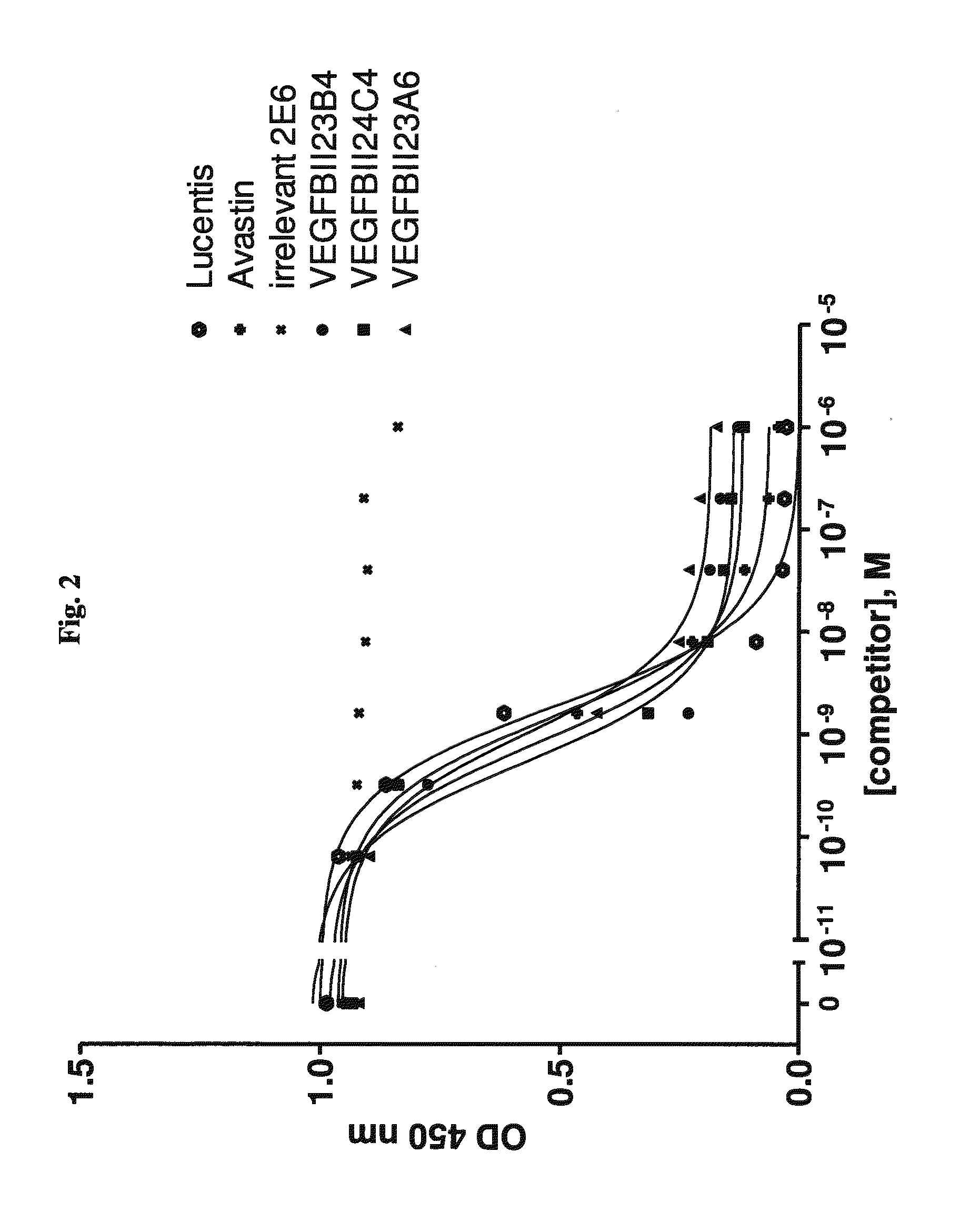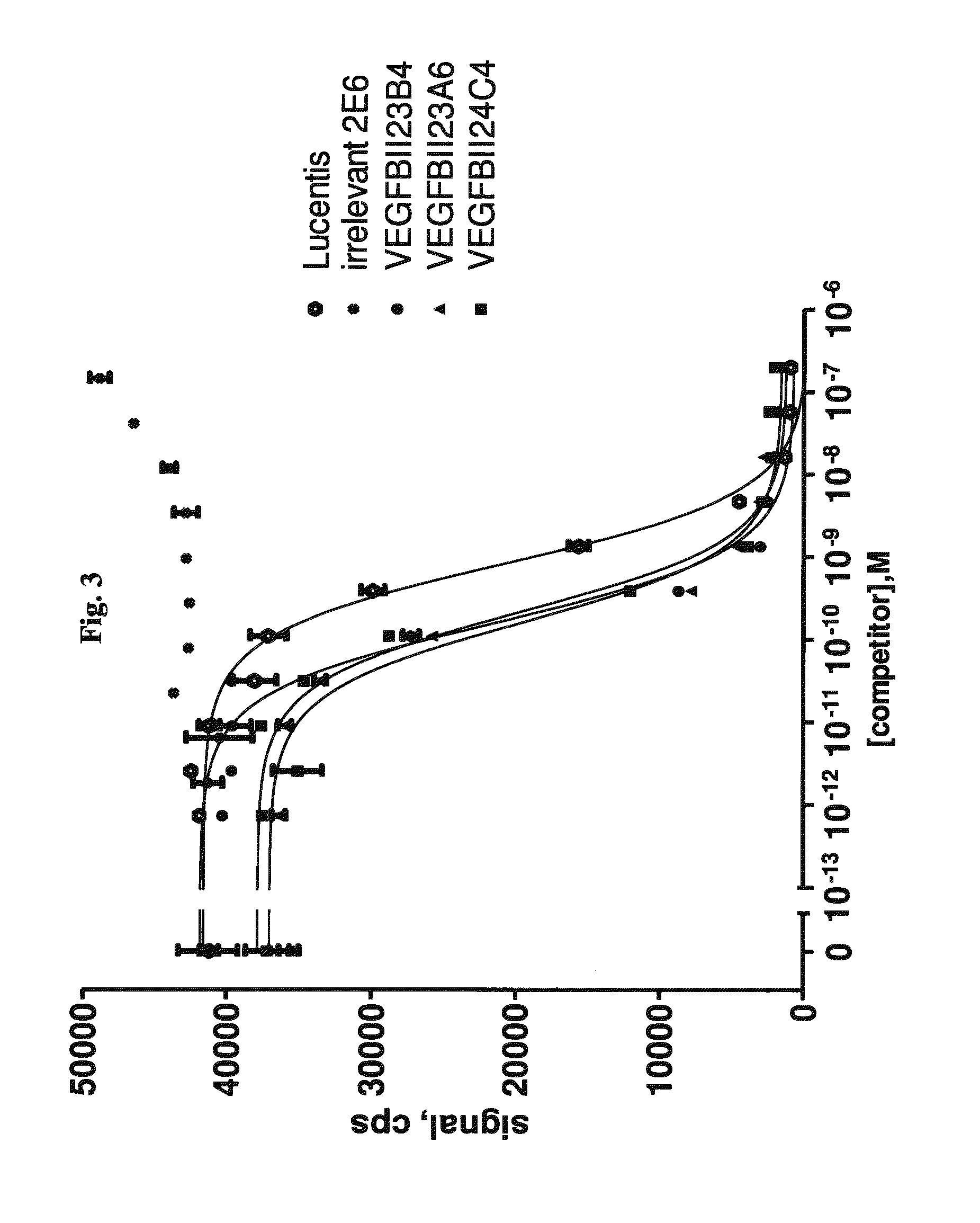Bispecific binding molecules binding to VEGF and ang2
a technology of bispecific binding molecules and vegf, which is applied in the field of human therapy, can solve the problems of persistent vascular defects in the retina and kidneys of ang2-deficient mice, and the lymphatic patterning defect is found in mice, and achieves the effect of increasing serum half-lik
- Summary
- Abstract
- Description
- Claims
- Application Information
AI Technical Summary
Benefits of technology
Problems solved by technology
Method used
Image
Examples
example 1
Immunization with Different VEGF Formats Induces a Humoral Immune Response in Llama
1.1 Immunizations
[0353]After approval of the Ethical Committee of the faculty of Veterinary Medicine (University Ghent, Belgium), 4 llamas (designated No. 264, 265, 266, 267) are immunized according to standard protocols with 6 intramuscular injections (100 or 50 μg / dose at weekly intervals) of recombinant human VEGF109. The first injection at day 0 is formulated in Complete Freund's Adjuvant (Difco, Detroit, Mich., USA), while the subsequent injections are formulated in Incomplete Freund's Adjuvant (Difco, Detroit, Mich., USA). In addition, four llamas (designated No. 234, 235, 280 and 281) are immunized according to the following protocol: 5 intramuscular injections with KLH-conjugated human VEGH165 (100 or 50 μg / dose at biweekly intervals) followed by 4 intramuscular injections of human VEGF109 (first dose of 100 μg followed 2 weeks later with three 50 μg / dose at weekly interval).
1.2 Evaluation of ...
example 2
Cloning of the Heavy-Chain Only Antibody Fragment Repertoires and Preparation of Phage
[0355]Following the final immunogen injection, immune tissues as the source of B-cells that produce the heavy-chain antibodies are collected from the immunized llamas. Typically, two 150-ml blood samples, collected 4 and 8 days after the last antigen injection, and one lymph node biopsy, collected 4 days after the last antigen injection are collected per animal. From the blood samples, peripheral blood mononuclear cells (PBMCs) are prepared using Ficoll-Hypaque according to the manufacturer's instructions (Amersham Biosciences, Piscataway, N.J., USA). From the PBMCs and the lymph node biopsy, total RNA is extracted, which is used as starting material for RT-PCR to amplify the VHH encoding DNA segments, as described in WO2005 / 044858. For each immunized llama, a library is constructed by pooling the total RNA isolated from all collected immune tissues of that animal. In short, the PCR-amplified VHH r...
example 3
Selection of VEGF-Specific VHHs Via Phage Display
[0356]VHH phage libraries are used in different selection strategies applying a multiplicity of selection conditions. Variables include i) the VEGF protein format (rhVEGF165, rhVEGF109 or rmVEGF164), ii) the antigen presentation method (solid phase: directly coated or via a biotin-tag onto Neutravidin-coated plates; solution phase: incubation in solution followed by capturing on Neutravidin-coated plates), iii) the antigen concentration and iv) the elution method (trypsin or competitive elution using VEGFR2). All selections are carried out in Maxisorp 96-well plates (Nunc, Wiesbaden, Germany).
[0357]Selections are performed as follows: Phage libraries are incubated at RT with variable concentrations of VEGF antigen, either in solution or immobilized on a solid support. After 2 hrs of incubation and extensive washing, bound phage are eluted. In case trypsin is used for phage elution, the protease activity is immediately neutralized by a...
PUM
| Property | Measurement | Unit |
|---|---|---|
| KA | aaaaa | aaaaa |
| KA | aaaaa | aaaaa |
| KA | aaaaa | aaaaa |
Abstract
Description
Claims
Application Information
 Login to View More
Login to View More - R&D
- Intellectual Property
- Life Sciences
- Materials
- Tech Scout
- Unparalleled Data Quality
- Higher Quality Content
- 60% Fewer Hallucinations
Browse by: Latest US Patents, China's latest patents, Technical Efficacy Thesaurus, Application Domain, Technology Topic, Popular Technical Reports.
© 2025 PatSnap. All rights reserved.Legal|Privacy policy|Modern Slavery Act Transparency Statement|Sitemap|About US| Contact US: help@patsnap.com



